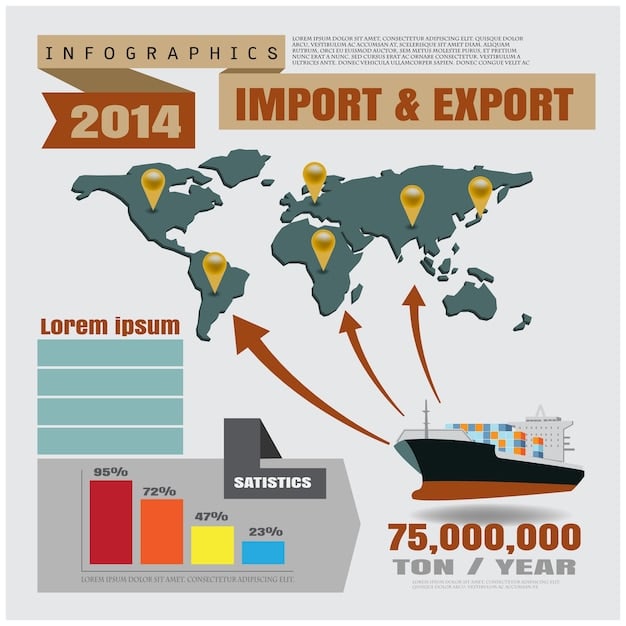Trade Deficit Impact: US Economy and Global Relations Analyzed

Trade Deficit Widens: Implications for US Economy and Global Relations refers to the economic condition where a country imports more goods and services than it exports, impacting economic growth, international relations, and domestic industries.
The latest reports indicate a significant widening of the trade deficit widens: implications for US economy and global relations, prompting concerns and discussions among economists and policymakers. Understanding the reasons behind this shift and its potential consequences is crucial for navigating the evolving economic landscape.
Understanding the Trade Deficit
A trade deficit occurs when a country’s imports exceed its exports over a given period. This imbalance can impact various aspects of a nation’s economy, from jobs and manufacturing to currency values and international relations. To fully grasp the implications, it’s essential to understand the contributing factors and how they intertwine.
What Causes a Trade Deficit?
Several factors can lead to a trade deficit, including higher levels of consumer spending, increased government debt, and weaker domestic production. Monitoring these elements can provide insights into the underlying causes of economic imbalance.
- Consumer Demand: Strong consumer demand for imported goods can increase imports, thereby widening the trade deficit.
- Currency Valuation: A strong domestic currency can make exports more expensive and imports cheaper, exacerbating the deficit.
- Economic Growth: Faster economic growth relative to other countries can lead to higher demand for imports.
The dynamics of global trade are complex. Shifts in currency valuation, changing consumer behavior and differences in economic growth can contribute to a trade deficit.

Impact on the US Economy
The widening trade deficit can have multiple effects on the US economy. While some economists view it as a sign of strong consumer demand and economic growth, others are concerned about its potential negative impacts on domestic industries and job creation.
Job Creation and Manufacturing
A persistent trade deficit can put pressure on domestic manufacturing industries, potentially leading to job losses. This is because local businesses may struggle to compete with cheaper imports.
- Job Displacement: Increased imports can lead to reduced demand for domestically produced goods, causing job losses in manufacturing sectors.
- Wage Stagnation: Competition from cheaper labor markets overseas can put downward pressure on wages in the US.
- Industrial Decline: Some industries may face decline as they struggle to compete with foreign producers, affecting the overall industrial base.
Examining economic indicators such as job creation rates and manufacturing output helps give a clearer view of the health of the US economy in relation to the trade deficit.
Effects on Global Relations
A significant trade deficit can strain international relations, particularly when it leads to trade disputes and protectionist measures. Understanding the diplomatic implications is essential for maintaining stable global partnerships.

Trade Disputes and Tariffs
Large trade imbalances can lead to trade disputes between countries, often resulting in the imposition of tariffs and other trade restrictions. This can disrupt global supply chains and harm economic growth.
- Tariff Wars: Countries may impose tariffs on each other’s goods in an attempt to reduce the trade deficit, leading to retaliatory measures.
- Trade Negotiations: Trade imbalances can lead to intense negotiations aimed at addressing unfair trade practices and promoting balanced trade.
- Geopolitical Tensions: Trade disputes can escalate geopolitical tensions between countries, affecting broader diplomatic relations.
International trade impacts geopolitical relationships. Trade deficits can impact these relationships as countries try to balance global partnerships.
Policy Responses and Strategies
Addressing the trade deficit requires a multifaceted approach, including fiscal policies, trade agreements, and investments in domestic industries. Policymakers must consider various options to mitigate the negative effects and promote balanced trade.
Fiscal Policies and Currency Management
Government policies related to taxation, spending, and currency management can play a significant role in influencing the trade balance.
- Fiscal Stimulus: Government spending aimed at boosting domestic demand can increase imports, potentially widening the trade deficit.
- Currency Intervention: Central banks may intervene in currency markets to influence exchange rates and promote exports.
- Tax Reforms: Tax policies that encourage domestic production and investment can help reduce the trade deficit.
Government decisions on trade and fiscality have a big impact on the economic health of the nation. Fiscal Policy requires an understanding of domestic industry, international markets and national finances.
Sector-Specific Impacts
The widening trade deficit affects different sectors of the US economy in various ways. Some industries may benefit from increased access to foreign markets, while others may struggle to compete with cheaper imports. Tailored support strategies can assist the industries most in need.
Agriculture
The agriculture sector is vulnerable to trade imbalances. Policies to promote exports and ensure fair competition can help mitigate any negative impacts.
Agricultural policies play an important role in domestic and international markets. Production, consumption and global trade is impacted by these choices.
Future Outlook and Predictions
Predicting the future trajectory of the trade deficit involves considering various factors, including global economic growth, policy changes, and technological advancements. Taking a long-term view can help prepare for upcoming economic shifts and challenges.
Economic Forecasts
Economic forecasts from institutions like the International Monetary Fund (IMF) and the World Bank can provide insights into the future of global trade and the US trade balance.
- Global Growth: Slower global economic growth may reduce demand for US exports, exacerbating the trade deficit.
- Policy Changes: New trade agreements or policy shifts could significantly impact the trade balance.
- Technological Advancements: Technological innovation can boost productivity and competitiveness, partially offsetting the negative impacts of the trade deficit.
Staying informed of the current, upcoming and historical economic information can help businesses navigate and prepare for potential fluctuations.
| Key Point | Brief Description |
|---|---|
| 📈 Rising Trade Deficit | Imports exceed exports, impacting the US economy. |
| 💼 Impact on Jobs | Manufacturing sectors face pressures from cheaper imports. |
| 🤝 Global Relations | Trade disputes can strain international partnerships. |
| 🏛️ Policy Responses | Fiscal and trade strategies aim to balance economic activity. |
FAQ
A trade deficit occurs when a country’s imports of goods and services exceed its exports over a specific period, typically a year. It signifies more money is leaving the country than is entering through trade.
A trade deficit can lead to job losses in domestic industries that compete with cheaper imports. As demand shifts towards foreign goods, local businesses may reduce production and workforce.
Yes, significant trade deficits can strain international relations, particularly if they lead to trade disputes. Countries may impose tariffs or other restrictions to reduce the imbalance, escalating tensions.
Policies to tackle trade deficits include fiscal measures, trade agreements, and boosting domestic industries. These efforts aim to promote balanced trade and reduce reliance on imports.
Economic forecasts from bodies like the IMF help predict global trade patterns and potential impacts on the US. Slow global growth may increase trade deficits by decreasing demand for US exports.
Conclusion
In conclusion, the widening trade deficit widens: implications for US economy and global relations poses multifaceted challenges and opportunities for the United States. Addressing this imbalance effectively requires careful consideration of domestic policies, international trade dynamics, and sector-specific impacts to ensure sustainable economic growth and stable global relations.





